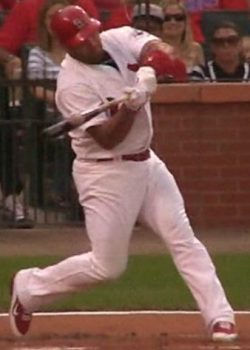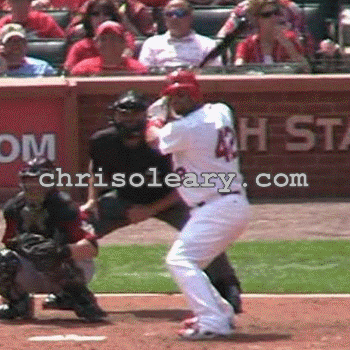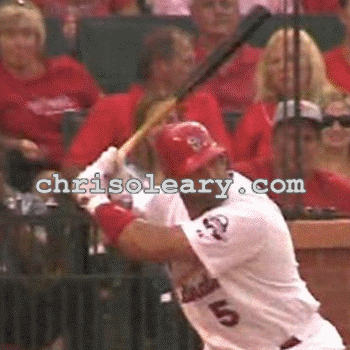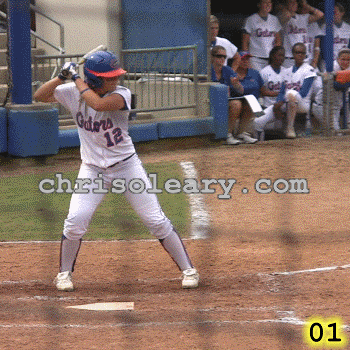I answer a lot of frequently-asked questions in my...
However, there are some other important topics and questions that need to be addressed before getting into a detailed discussion about hitting.
1.1. The high-level swing: baseball vs. fast pitch softball 
1.1.1. The slight uppercut and fast pitch softball
1.2. The role of the hands in the swing
1.2.1. Wrist snap
1.3. Hitting the curveball
1.3.1. Delaying mechanism 
1.4. Moving beyond the A to C Swing 
1.4.1. The Myth of the A to C Swing 

1.5. Backspin
1.5.1. The Myth of Backspin 
1.6. Get your back elbow Up?
1.7. How high should you hold your hands?
1.7.1. When should the hands drop below the shoulders?
1.7.2. How do you hit the high pitch?
1.7.3. How do you hit high inside strikes?
1.8. What is the proper role of the hands?
1.8.1. How much is disconnection?
1.9. How hard should you swing?
1.10. Loop in the swing
1.11. Weight shift
1.12. Ground balls, line drives, or fly balls
1.13. Tilt and the Pitch Low and Away
1.14. What Causes Pop-Ups?
The High-Level Swing: Baseball vs. Fast Pitch Softball
What are the differences between the baseball and fast pitch softball swings? How do they have to be taught differently?
As I explain in my piece on The High-Level Swing, there are very few differences between a high-level baseball and fast pitch softball swing.
Is a Slight Uppercut Appropriate for Fast Pitch Softball?
I am considering ordering your rotational hitting DVD for my daughter. She is looking to develop more power. I am concerned with one aspect, which is the "uppercut swing" that goes along with the rotational hitting. I understand & agree 100% with the idea of the slight (10-15 degree) uppercut with regard to baseball..and you state it very well on your site: "...since every pitch crosses the plate on a slight downward angle, the way to hit pitches squarely is to swing with a slight uppercut". However, in softball, due to the flat pitchers mound and the underhand delivery, the pitches typically cross the plate flat or on a slight upward angle.
So my question is how is it beneficial to swing with a slight uppercut in this scenario? It would seem this is directly contrary to the baseball scenario.
I have studied this in depth and have yet to find a fast pitch softball pitch that is a strike that actually rises through the Point Of Contact. Yes, some rise-balls DO rise through the Point Of Contact, but those are balls and not strikes and hitters shouldn't swing at them. Every strike I have looked at is either descending or at most level to the ground, and when good hitters put good swings on these pitches they swing with a slight uppercut.
Also, good fast pitch softball pitchers work the bottom of the strike zone just as much as good baseball pitchers do and that is because the ball down in the strike zone is the hardest one to adjust to and still hit hard. Most hitters just drop their hands at that pitch.
What is the Proper Role of the Hands?
Some people believe that the role of the hands is to turn the barrel and to act as a second engine; to apply Top Hand Torque and boost the power that is generated by The Core. I believe that, while hands have an essential role to play, their job isn't to generate power. The the muscles of hands, wrists, and forearms are simply too small.
I discuss this topic in greater detail in my piece on The Role of the Hands.
Wrist Snap
How does not snapping the wrists before contact slow the bat down? Don't we stress in throwing the last 5% of the wrist is the most important part to extra velocity? Fast pitch SB where snap is focused on for more speed along with hips? Shooting a basketball with the follow through?
The research I have read says that the wrist snap is highly over-rated and is generally the effect of a good swing (or throw) and not the cause of a good swing (or throw).
In a good swing, once the hitter releases the barrel, the wrists serve as a free-swinging hinge and there is no need to try to force them to snap. In fact, trying to actively snap the wrists can actually reduce the speed at which the wrists will naturally snap on their own. As a result, I believe that actively trying to snap the wrists, as opposed to just letting them snap, is a bad idea.
Strong Hands and Wrists
Why do good hitters like Ted Williams have strong hands and wrists?
Ted Williams said the hands and wrists need to be strong to brace the barrel at contact (aka unbroken wrists). However, video of him and of other good hitters shows that, at the point of contact, they aren't at the brace position that Ted Williams thinks is so important. Instead, at the point of contact the barrel is in line with the front arm and not lagging behind the front arm and at the Whip Position at or just after contact.
IMO, and as someone once said (perhaps Williams) the reason why hitters benefit from having strong wrists and hands is that that lets you hold onto the bat securely but still keep your wrists loose so that the barrel will Whip around the hands.
Hitting the Curveball
One key to hitting the curveball is having a Delaying Mechanism in your swing that allows you to start your swing early enough to hit the fastball but that also allows you to hit a curveball or other off-speed pitch. The strongest indicator that a lack of a Delaying Mechanism is your problem is if you can see the curveball but you are always out in front of it and can't hit it hard, if at all.
Keeping your hands back and holding the Hinge Angle as long as possible is also important to being able to hit the curveball hard.
Backspin
Lots of people spend a lot of time talking about backspin and how to get it. However, I am extremely skeptical about those claims and think that trying to put backspin on the ball is a bad idea (if not practically impossible).
First, and as I discuss in my piece on The Myth of Backspin, I'm not sure that backspin is necessary to hitting a ball a long way.
Second, the things that people recommend that you to to create backspin -- like taking the knob of the bat directly down to the ball, keeping the front elbow down, keeping the bat head from dropping or looping, and pushing with the top hand -- tend to result in choppy swings with lots of Push Disconnection that look nothing like the swings of good hitters like Albert Pujols and instead look like the swings of terrible hitters like Joe Thurston.

Joe Thurston
The picture below, of Albert Pujols just missing a home run by maybe 1/8 of an inch, also makes me doubt whether trying to put backspin on a ball is a good idea.

Albert Pujols
Fly Out to the Warning Track
If one of the greatest hitters ever can't consistently hit a ball just where he wants to, what hope do ordinary people have of doing that?
What's more, Pujols actually hit under this ball and put backspin on it, but he put too much backspin on the ball for it to carry out.
While golfers can and do put spin on a ball, they are hitting a ball that isn't moving. I think it makes more sense for baseball and softball players, who are trying to hit a ball that is moving rapidly toward them, as well as horizontally and/or vertically, to just try to hit the ball square.
Like Ted Williams, I think any attempt to spin the baseball is misguided because either uppercutting or swinging down on the ball will reduce the time the bat head stays on plane with the pitch. That is because either way you are cutting across the path of the ball. I'd rather stay on plane longer and take my chances with the spin of the ball.
Get the Back Elbow Up?
I discuss this very common, but potentially problematic, cue in my piece, Get Your Back Elbow Up?
How High Should You Hold Your Hands?
Because you are fighting gravity and physics, it's hard to raise the hands or the barrel more than a few inches during the swing. As a result, your hands have to be higher than the highest pitch you will swing at at the moment your front heel plants. Most hitters hold their hands higher than this in order to give themselves some space to work with during their load. They then have to drop them some to adjust, but you don't want to drop them very much or else you won't be able to cover the top of the strike zone.
At what point, if any, do you think a hitter's hands should drop below their back shoulder? I realize it may vary depending on pitch, but a lot of high school and college hitters have this problem. Ryan Braun always seems to work on deck with his hands above his shoulders the entire swing to repeat the movement. In short, trying to achieve what I think to be correct we set a tee up even with the back foot of the hitter on the inside black just below the arm pits. In your expert opinion do you think the hands should be above the back shoulder for how long if any when the hands launch while getting the barrel on the same plane as the shoulders?
When the hands drop below the shoulders is going to vary some according to the height of the pitch, but if you are dropping your
hands a lot then you are killing your power. You want to keep the hands in alignment as long as possible, which means you want to keep the hands up and adjust more with tilt.
When I look at Pujols, his hands do drop a bit at the start of his swing, but still stay up around his back shoulder in alignment. If they do drop below the shoulders, it's generally just a few frames before the POC when he transitions from The Parallelogram to The L (and the hands are definitely a bit below the shoulders in The L).
I use the Shaft To Shoulder position, and the Inverted Triangle shape, as a checkpoint. At the STS position the hands are generally still up in the plane of the shoulders if you are doing it right.
I have posted some Pujols clips to show what he does.
Hitting the High Pitch
How do you teach hitting a pitch up in the zone with the elbow of the front arm so high? Don't the hands have to turn the club head up high to create the path to the ball that's up in the zone (example 1-2 or 0-2 pitch that could be called a strike). Otherwise the path never changes with the arms raising & player remains under the ball.
The front arm sets the swing plane, so the front elbow has to be up to for the swing plane, and thus the bat head, to be up.
Below are two clips of Albert Pujols hitting pitches at the top of the strike zone. Notice how high his front elbow gets. That is important because where the front arm and elbow go, the barrel of the bat also goes.

Albert Pujols
Hitting a High Pitch

Albert Pujols
Hitting a High Pitch
Hitting High Inside Strikes
How do you get to a high and inside pitch (borderline strike) without getting on top of the ball to create an angle to hit a line drive fair?
To hit a high inside pitch, you don't want to get on top of the ball because that will just drive it into the ground. Instead, you want to get behind the ball. That is done with a combination of driving the front elbow up and around and also flexing the front elbow more than usual to keep your hands inside the ball as Megan Bush does in the clip below.

Megan Bush
Hitting a Home Run on a High Inside Pitch
How Hard Should You Swing?
The motor learning research on hitting that I have read says that it's best to swing fairly hard.[1] Not as hard as you can swing, but not too much slower than that. The phrases I have used, and that have worked, are "Swing for doubles," and "Get the ball to the wall."
In particular, "Swing for doubles," was one of the main things I told Andres Torres when he was slumping at the start of the 2010 NLCS. The idea is that you can't slow down your swing too much or you won't be able to catch up to a good fastball, but you don't want to swing for home runs because that can lead to problems like pulling off the ball.
Instead, you should just let home runs happen.
Disconnection
How far do the hands have to get from the torso to be disconnected? I see several great swings with HR power that aren't alligator arms. How is that not disconnection and, if it's disconnection, how is that not bad?
The simplest way to judge disconnection is to look for the Power L in the back arm. If it's there, it's likely that the hitter is connected. If it's not, and there's no good reason for it not to be (e.g. middle middle fastball or hitting off of a tee), then the hitter likely has a problem with disconnection.
However, you need to remember that hitters will be more extended if they have to make a Z-Axis adjustment, or timing, adjustment to an off-speed pitch. Extending the arms is how hitters make a timing adjustment to an off-speed pitch.
However, if a hitter habitually extends at the POC, even on middle middle fastballs, then they won't be able to make a Z-Axis adjustment if they need to and will just be early on off-speed pitches.
That is the problem with teaching extension at the POC on every pitch.
Loop in the Swing
How do you teach a player with a terrible loop in their swing to hit with back spin without using hands?
First, I don't like the term "loop" because people use it to describe any uppercut, and I think most, if not all, good swings are uppercuts (an uppercut being a swing where the bat head gets below the hands). You certainly can have an excessive uppercut, but in my experience the fix isn't in the hands. Rather, the fix is to reduce the lean back toward the catcher (aka lateral tilt) and not drop the back shoulder as much.
My two tee drill is how I deal with the problem of an excessive uppercut, in part just by giving the hitter a sense of where the ball should actually go.
Weight Shift
With weight shift, why stride at all? It can be early-late-or on time. Isn't that too inconsistent? As in the case of Ben Hogan, power & weight shift can occur with stepping & the head stays still & over center of gravity.
While the stride can cause inconsistencies, it can also add momentum and power to the system (and power contributes to average).
While I don't have a problem with a hitter stripping down their swing and going with a no-stride swing if they feel they have to, I will suggest that the hitter add in a bit of a stride if they need a bit more power.
Having said that, I will say that you can certainly go overboard when it comes to the stride.
For a variety of reasons, Andres Torres tends to hit much better with a smaller stride than with a larger stride. Toward the end of the 2010 season and during the 2010 NLDS he was using a big Soriano leg kick -- in part because he was trying to hit home runs, which is a no-no -- and it was causing a lot of head movement and a timing problem. We talked before the NLCS and he decided to tone down. Once he also stopped trying to pull outside pitches, he ended up hitting extremely well in both the NLCS and World Series.
Ground Balls, Line Drives, or Fly Balls
What should I teach my hitters to try to hit: ground balls, line drives, or fly balls?
I discuss this topic in detail in my piece on line drives, hitting the ball hard, and success.
Tilt and the Pitch Low and Away
We are working with my older son’s swing – which has benefited greatly from this site and your philosophies – but have reached an impasse on how to hit the pitch down and away in the strike zone. I realize few people hit this pitch consistently, but I am using Tilt as my means of working on getting my son to the baseball and he is not fond of this approach.
I’ve read and re-read the Tilt section and really haven’t been able to fully explain this to my son or his coach. Do you have any additional resources or some drills we could use to focus on tilt. I’ve been placing the tee knee high on the outside corner and having my son take cuts from there, but it has yet to really translate to live pitching. I am putting the tee fairly far back in his stance, so to continue to promote his hinge angle through the swing.
When I slow down the video, what I see is he wants to push his hands away from his body and try to “reach for” the ball – which destroys his hinge angle and robs him of all power.
The pitch low and away is the hardest one to hit hard, which is why the slider is so popular and so effective and why good pitchers live down there (that was where Leo Mazzone wanted his pitchers to live). As a result, it is often best to take that pitch as long as you can and wait for a pitch that is easier to hit.
However, if taking the pitch isn't an option, and you are 0-2 and know the pitch may go down there, then there are a few things you can do, and I discuss them in my piece on Tilt and Hitting the Pitch Low and Away, which is part of my Advanced Hitting Mechanics webbook.
What Causes Pop-Ups?
What should I be looking for if my son is popping up. He doesn't do it all that often, but when he does he continually gets the instruction from his coach to stop dropping his back shoulder. Is there something that has a tendency to cause pop ups? My son understands that the swing level and don't drop your your back shoulder comments don't lead to hitting the ball hard, but I'd like to be able to tell him what typically cause pop ups.
Often, pop-ups are caused by chopping down on the ball. That can be caused/worsened by telling a hitter to stop dropping their back shoulder and to keep the shoulders level, because that can cause them to drop their hands.
Usually, when someone is truly dropping their back shoulder and swinging with an excessive uppercut, they will tend to top the ball and hit it into the ground.
Notes
[1] See Schmidt and Sherwood (1982).